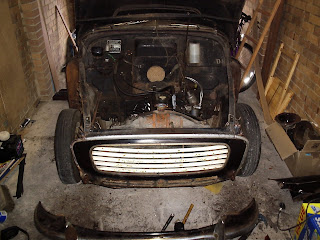Aye, so I was sat at work and got to thinking about the heat shield beneath the passenger footwell (as you do). Then it suddenly dawned on me, "hmmm - I bet that's asbestos".
So I posted a question on the
MMOC forum and yes, it is Asbestos - bugger. Apparently, it's white asbestos, and depending on its age, the clutch might be asbestos too, and the brake linings (at least when it was new) - but I knew this anyway.
The hole through the passenger footwell (the browny triangle)
The heatshield is mounted above the front baffle of the exhaust.
The white bit inside the heatshield is the asbestos.
Some of the members on the MMOC forum suggested that if its doing no harm, then leave it alone - but because you can see it through the hole in the floor and it might end up killing me, and anyone that rides in the car, I thought I better get rid.
I did a bit reading up on the actual dangers of asbestos, and the safest ways of removing it. I found the health and safety executive has a good section on asbestos at
http://www.hse.gov.uk/asbestos/. I also spoke to the local council to see how to dispose of it, who recommended the following:
- Dampen the area down
- Wear protective clothing such as overalls (disposable preferably)
- Wear dustmask and gloves
- Avoid using powertools to reduce chance of breaking the material
- Dispose in double-bagged heavy-duty polythene bags, along with the overalls.
- Seal and label the bags
- Contact the council to arrange free disposal when next doing one of their "hazardous waste" pickups.
So following advice, I sprayed it with water to dampen down the fibres. Then taped over the hole in the floor, and taped a thick rubble sack to the underside of the car ready.
Once I was ready to catch the heatshield from underneath, I ground off the screw heads that were holding the heatshield on from the inside of the car. I would have preferred to unscrew them, but they were thick with gunk and wouldn't budge. After grinding the heads off, a swift whack with a mallet on the screws knocked them out and the heatshield fell onto the exhaust into the rubble sack I had taped to the underside of the car. I rolled this around the heatshield, then carefully double-bagged it in another two rubble sacks and taped them up. As recommended by the council, I did the same with the overalls I was wearing, and to be sure, my trainers aswell - they shouldnt have been binned years ago anyway.
Heatshield gone
I know it might seem a little over the top for what was just a little bit, but all of the research I did pretty much suggests to take no chances. I've just got to find something else to use as a heatshield now!






















































